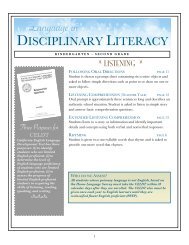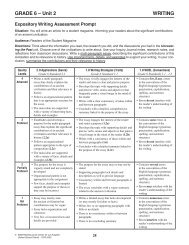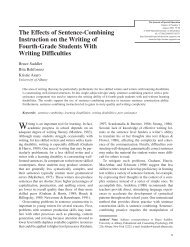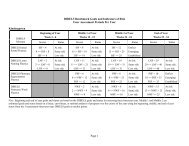Beyond Phonics: Integrated Decoding and Spelling Instruction ...
Beyond Phonics: Integrated Decoding and Spelling Instruction ...
Beyond Phonics: Integrated Decoding and Spelling Instruction ...
You also want an ePaper? Increase the reach of your titles
YUMPU automatically turns print PDFs into web optimized ePapers that Google loves.
DECODING AND SPELLING— WORD ORIGIN AND STRUCTURE 263Greek LayerGreek words, like many of their Romance counterparts, entered Englishby the thous<strong>and</strong>s during the Renaissance to meet the needs of scholars<strong>and</strong> scientists. Letter-sound correspondences are similar, but wordsof Greek origin use the sounds of /ph/, /ch/, <strong>and</strong> /y/ found in chlorophyll.The Greek layer tends to compound forms or roots in words appearinglargely in scientific texts (e.g., microscope, hemisphere, physiology). Thefollowing passage from a middle school science text (Cooper et al. 1985)shows how short words of Anglo-Saxon origin mix with longer Romancewords, but how the scientific terminology is couched in words of Greekorigin.Suppose you could examine a green part of a plant under the microscope.What would you see?Here are some cells from the green part of a plant. The cells havesmall green bodies shaped like footballs. They give the plant its greencolor. They are call chloroplasts. A single green plant cell looks likethis.Chloroplasts are very important to a plant. As you know, plantsmake their own food. This food-making process is called photosynthesis.It is in these chloroplasts that photosynthesis takes place. (p. 20)What the Child Needs to KnowThe structural-historical framework shows what the child who islearning to read needs to know. The reader needs to recognize the soundpatterns of speech in the symbols printed on a page. The problem for thelearner is to decode the print to represent for himself or herself a coherentset of sound representations. For example, the student must learn thatwords can be broken down in several ways; that words are made of lettersthat have sounds; <strong>and</strong> that words are made up of syllables <strong>and</strong> ofmorphemes.Thus, students need to learn the following:1. A number of letter-sound correspondences organized within categoriessuch as consonants, vowels, blends, consonant digraphs,<strong>and</strong> vowel digraphs.2. The most common ways to divide words into syllables.3. Common morpheme patterns—prefixes, roots, suffixes, <strong>and</strong>compounds.4. The productive rules of the written form of the language.5. An underst<strong>and</strong>ing of the history of the English language in orderto underst<strong>and</strong> the apparent complexities of the written languageby contrasting (a) the regularity of words of Greek <strong>and</strong> Latinorigin with Anglo-Saxon words that generally have less regularletter-sound correspondences, <strong>and</strong> (b) syllabic <strong>and</strong> morphemicpatterns that differ according to word origin.






